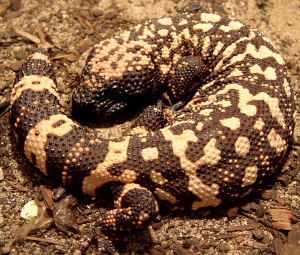 If you're lucky enough to have a backyard or neighborhood with a little natural diversity, a lizard or lizard kin might show up one day sunning on the house's foundation, climbing up a tree trunk, or, like the Southern Fence Lizard, Sceloporus undulatus undulatus, pictured at the left, hanging on a barn door in southern Mississippi.
If you're lucky enough to have a backyard or neighborhood with a little natural diversity, a lizard or lizard kin might show up one day sunning on the house's foundation, climbing up a tree trunk, or, like the Southern Fence Lizard, Sceloporus undulatus undulatus, pictured at the left, hanging on a barn door in southern Mississippi.
 Something neat about many species in the Lizard Family is that they can walk up walls. At the right you see the bottom of a foot of a Green Anole, Anolis carolinensis. There are no suction cups or glue-spots on the foot, so what makes the foot stick to walls?. The enlarged toe pads clearly visible in the picture are equipped with millions of microscopic hooks which grip irregularities in surfaces. Geckoes have a different wall-climbing system. Their feet bear scales covered with jillions of microscopic hairlike bristles, and at the tip of each bristle is a minute suction cup...
Something neat about many species in the Lizard Family is that they can walk up walls. At the right you see the bottom of a foot of a Green Anole, Anolis carolinensis. There are no suction cups or glue-spots on the foot, so what makes the foot stick to walls?. The enlarged toe pads clearly visible in the picture are equipped with millions of microscopic hooks which grip irregularities in surfaces. Geckoes have a different wall-climbing system. Their feet bear scales covered with jillions of microscopic hairlike bristles, and at the tip of each bristle is a minute suction cup...
BACKYARD LIZARDS AREN'T DANGEROUS, UNLESS...
 Gila monster, Heloderma suspectum, at the American International Rattlesnake Museum, via "Blueag9" and Wikimedia Commons
Gila monster, Heloderma suspectum, at the American International Rattlesnake Museum, via "Blueag9" and Wikimedia CommonsThe only venomous lizard in North America is the Gila Monster, restricted to the Desert Southwest. With its very thick body and wide bands running crosswise, it's not likely to be mistaken for anything else. Therefore, in North America, our backyard lizards can be considered as completely safe -- as long as we're not in Gila Monster territory.
You might be interested in browsing Naturalist Jim Conrad's lizardy notes accumulated during years of travel in lizardy places.
A SHOCKING EXPERIENCE...
However, be forewarned that a number of species, when caught, shed their tails. As the tail writhes furiously, the lizard escapes. This is an adaptation to confuse and shock the enemy -- which is does very well! Below you can see a Silky Anole, Anolis sericeus who lost his tail, but now it growing back!

